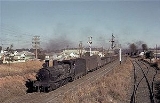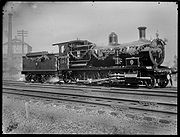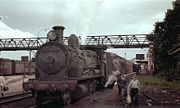
New South Wales D53 class locomotive
Encyclopedia
The D53 class is a class of 2-8-0
steam locomotive
built for and operated by the New South Wales Government Railways
of Australia
.
 This class of locomotive was designed by the New South Wales Government Railways
This class of locomotive was designed by the New South Wales Government Railways
as a modification of the earlier T(524)-class, after 1924 classified 50-class. All the coupled wheels had flanges and a certain amount of side movement was given to the middle pairs with a laterally operating knuckle joint
being provided in the middle section of the coupling rods.
The Clyde Engineering
Company delivered the first locomotive in April, 1912 and, by November, 1917, a total of 190 were in service, 160 from Clyde and 30 from the NSWGR
Eveleigh Workshops. Most were fitted with superheaters when built and some fitted at a later date. The superheaters caused some initial difficulties, giving the class a bad name. There was also a problem with the locomotives being unbalanced, causing speed restrictions to be imposed to avoid rough riding and track damage. Following further investigations, 24 of the class were re-balanced and these were permitted to operate at a faster speed which made them useful on Wollongong
There was also a problem with the locomotives being unbalanced, causing speed restrictions to be imposed to avoid rough riding and track damage. Following further investigations, 24 of the class were re-balanced and these were permitted to operate at a faster speed which made them useful on Wollongong
suburban passenger services.
When introduced, most of the class were fitted with a standard bogie tender, similar as those attached to the 50-class, although some saw service with Wampu tenders. In the later period of their lives, the majority were fitted with larger turret type tenders. To enable tender first running, many had automatic couplers fitted to the front.
Following the removal of the knuckle joints from the coupling rods, flanges from the second coupled and driving wheels and the fitting of boilers standard for 50-class; 53-class and 55-class, they became most useful locomotives.
Many were in service right to the end of the steam era, four surviving to the very last day.
The then Commonwealth Railways
used the design of these locomotives for their KA-class for the Trans-Australian Railway
.
and is currently displayed with a WAMPU Tender at their Valley Heights museum. 5353 is preserved by the Dorrigo Steam Railway and Museum
. 5367 was preserved by the Lachlan Valley Railway
, and after providing many years of sterling service to the group is the subject of an attempt to return it to steam.
2-8-0
Under the Whyte notation for the classification of steam locomotives, 2-8-0 represents the wheel arrangement of two leading wheels on one axle , eight powered and coupled driving wheels on four axles, and no trailing wheels...
steam locomotive
Steam locomotive
A steam locomotive is a railway locomotive that produces its power through a steam engine. These locomotives are fueled by burning some combustible material, usually coal, wood or oil, to produce steam in a boiler, which drives the steam engine...
built for and operated by the New South Wales Government Railways
New South Wales Government Railways
The New South Wales Government Railways was the government department that operated the New South Wales Government's railways until the establishment of the Public Transport Commission in 1972. Although later known officially as the Department of Railways, New South Wales, it was still generally...
of Australia
Australia
Australia , officially the Commonwealth of Australia, is a country in the Southern Hemisphere comprising the mainland of the Australian continent, the island of Tasmania, and numerous smaller islands in the Indian and Pacific Oceans. It is the world's sixth-largest country by total area...
.
History

New South Wales Government Railways
The New South Wales Government Railways was the government department that operated the New South Wales Government's railways until the establishment of the Public Transport Commission in 1972. Although later known officially as the Department of Railways, New South Wales, it was still generally...
as a modification of the earlier T(524)-class, after 1924 classified 50-class. All the coupled wheels had flanges and a certain amount of side movement was given to the middle pairs with a laterally operating knuckle joint
Knuckle joint (mechanical)
A knuckle joint is used to connect the two rods which are under the tensile load, when there is requirement of small amount of flexibility or angular moment is necessary. There is always axial or linear line of action of load....
being provided in the middle section of the coupling rods.
The Clyde Engineering
Clyde Engineering
Clyde Engineering was the name of part of the business now known as Downer EDI Rail. Clyde Engineering were involved in the construction of railway locomotives and rolling stock, as well as larger scale engineering projects on behalf of the governments of Australia...
Company delivered the first locomotive in April, 1912 and, by November, 1917, a total of 190 were in service, 160 from Clyde and 30 from the NSWGR
New South Wales Government Railways
The New South Wales Government Railways was the government department that operated the New South Wales Government's railways until the establishment of the Public Transport Commission in 1972. Although later known officially as the Department of Railways, New South Wales, it was still generally...
Eveleigh Workshops. Most were fitted with superheaters when built and some fitted at a later date. The superheaters caused some initial difficulties, giving the class a bad name.

Wollongong, New South Wales
Wollongong is a seaside city located in the Illawarra region of New South Wales, Australia. It lies on the narrow coastal strip between the Illawarra Escarpment and the Pacific Ocean, 82 kilometres south of Sydney...
suburban passenger services.
When introduced, most of the class were fitted with a standard bogie tender, similar as those attached to the 50-class, although some saw service with Wampu tenders. In the later period of their lives, the majority were fitted with larger turret type tenders. To enable tender first running, many had automatic couplers fitted to the front.
Following the removal of the knuckle joints from the coupling rods, flanges from the second coupled and driving wheels and the fitting of boilers standard for 50-class; 53-class and 55-class, they became most useful locomotives.
Many were in service right to the end of the steam era, four surviving to the very last day.
The then Commonwealth Railways
Commonwealth Railways
The Commonwealth Railways were established in 1912, as part of a government department, currently called the Department of Infrastructure, Transport, Regional Development and Local Government, by the Government of Australia to construct the missing link in the east-west transcontinental railway and...
used the design of these locomotives for their KA-class for the Trans-Australian Railway
Trans-Australian Railway
The Trans-Australian Railway crosses the Nullarbor Plain of Australia from Port Augusta in South Australia to Kalgoorlie in Western Australia...
.
Preservation
5461 was selected for preservation by the New South Wales Rail Transport MuseumNew South Wales Rail Transport Museum
The New South Wales Rail Transport Museum located in Thirlmere, New South Wales south-west of Sydney, is a museum dedicated to displaying former locomotives, carriages and goods wagons from the New South Wales Government Railways as well as private operations in NSW. The collection features steam,...
and is currently displayed with a WAMPU Tender at their Valley Heights museum. 5353 is preserved by the Dorrigo Steam Railway and Museum
Dorrigo Steam Railway and Museum
The Dorrigo Steam Railway and Museum in Dorrigo, New South Wales, Australia is a large, privately owned collection of preserved railway vehicles and equipment from the railways of New South Wales, covering both Government and private railways...
. 5367 was preserved by the Lachlan Valley Railway
Lachlan Valley Railway
The Lachlan Valley Railway Society Cooperative Limited is a non-profit rail preservation society based in the NSW Central Western town of Cowra, New South Wales, Australia. The museum's ex-NSWGR fleet ranges from their operational steam and diesel locomotives, to the fleet of heritage passenger...
, and after providing many years of sterling service to the group is the subject of an attempt to return it to steam.

